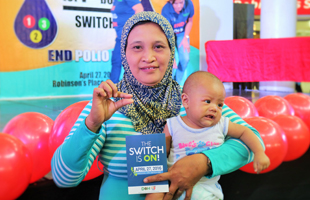
In the largest synchronized event in the history of vaccines, 155 countries and areas have simultaneously participated in the switch to a new oral polio vaccine (OPV) between 17 April and 1 May. 16 Member States in the Western Pacific Region successfully made the switch.
"It is the first time a changeover of this scale has been attempted. We are pleased that Member States in the Western Pacific were able to make all the necessary logistical arrangements to ensure a smooth transition," said Dr Shin Young-soo, WHO Regional Director for the Western Pacific.
“OPV has been instrumental in the battle to rid the world of polio,” Dr Shin added. “We have successfully reduced the prevalence of polio by 99%. But as we near the finish line we need to adopt new tactics to ensure we eradicate this disease once and for all.”
The reason for the switch
Over the past decade, more than 10 billion doses of OPV have been given to nearly three billion children worldwide, preventing more than 10 million cases of polio. The use of OPV has been key in reducing cases of polio by 99% and protecting children from lifelong paralysis.
OPV contains attenuated (weakened) polioviruses. On rare occasions, use of OPV can result in adverse events not seen with inactivated poliovirus vaccine (IPV). For this reason, the global eradication of polio requires the eventual cessation of all OPV in routine immunization as soon as possible after the eradication of wild poliovirus transmission.
The successful eradication of wild polio virus type 2
Wild poliovirus has 3 strains: types 1, 2, and 3. In September 2015, a declaration was made announcing the worldwide eradication of type 2. As a result of this success the type 2 component of OPV is no longer needed. This is good news for children and the polio eradication programme. Countries can now switch from trivalent OPV to bivalent OPV, a different vaccine that contains only type 1 and type 3 vaccine strains, making it both stronger and safer.
Following future type 1 and type 3 eradication, the use of all OPV in routine immunizations will eventually be stopped and replaced with IPV.
Switch in the Region
All 16 countries from the Western Pacific Region that still use OPV were involved in the switch from trivalent OPV to bivalent OPV. It is important that all countries currently using tOPV switch during the same time period.
WHO response
As part of the Polio Eradication and Endgame Strategic Plan, WHO has been supporting Member States to ensure highly sensitive surveillance for all polioviruses in order to document the elimination of type 2 poliovirus transmission and to rapidly detect the potential re-emergence of any type 2 poliovirus.
At the same time, work is being done to strengthen outbreak response capacity and implement appropriate and timely containment measures to minimize the risk of re-introduction into a type 2 polio-free world.




